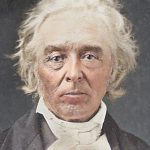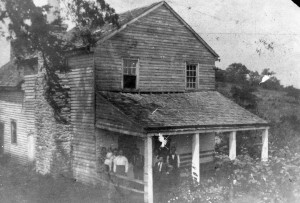The family story goes that in 1818, very much against his father’s wishes, Robert Haviland set sail for New Orleans. While traveling down the Ohio River, he turned south to travel the Licking River. Be it by accident or not, fate was soon to happen.
The trip down the Licking River to where Richland Creek meets is around 60 miles by river and 38 miles in a straight line. But, the trip was made. It is said that near the end of this trip, he was floating along and saw a beautiful woman on the river bank. He stopped. They courted and in 1820, he married Mary Cole Stewart.
Mary’s father, William Stewart and Robert Scott are supposed to have been among the first, if not the very first, white settlers in the Richland Precinct. They both planted orchards at a very early day, trees of which are still standing, and are bearing fruit. Scott gave name to the “Scott apple” since called by nurserymen “Milam.” It is told of Simon Kenton, the pioneer and great Indian fighter, that he has often helped to make cider in the orchard of William Stewart. It was also visited, when in early bearing by Daniel Boone. A few trees now are all that are left of these early efforts at fruit growing.
William Stewart is believed to have built the first water-mill. It was built on Richland Creek, near where now stands the little village of Havilandsville, but ceased work many years ago.
Robert Sheffield Haviland emigrated to Ky., in 1818; educated for sea captain; farmer; merchant; manufacturer; Methodist. He was a Methodist exhorter and it is said he could not be excelled in prayer. In 1845 he, with his wife, made his last visit to New York to see his mother and A. T. Stewart to whom his wife was related. While on that visit he led in prayer in Trinity Church and his mother gave him one thousand dollars for the first prayer he made in her house and in her hearing; when he came home he invested that one thousand dollars in a negro woman to wait on his wife, at the request of his mother.
The Haviland Home was large and the story told that once in the early days, while a big dinner was in progress, the dogs began chasing a pet deer outside. The frightened animal ran through the house and literally leaped across the laden table in his flight. It created a sensation but didn’t halt the meal.
The History of Harrison County, Ky., says that Robert S. Haviland taught the first school in the Richland Precinct in 1819. Richland Precinct is a collection of villages and Havilandsville is the most pretentious of them all. It is located about fifteen miles northeast of Cynthiana and was named for Robert Sheffield Haviland, father of the present judge of Harrison County. He was one of the most enterprising men ever in the precinct. The first store was kept by him where the village now stands, as early as 1832-33. He also put up a woolen and cotton factory in 1838 and manufactured jeans and lindseys for the Southern trade, which were transported in wagons and raw cotton brought back in return. He manufactured and shipped tobacco to New York and also operated a large porkpacking establishment, butchering from eight hundred to two thousand hogs annually. These were made into bacon and, together with manufactured goods, were shipped in flat boats, the cargoes of which were often worth sixty thousand dollars.
[posts-to-page category=”34″ link_title=true show_categories=”false” show_tags=”false” show_date=”false” show_author=”false”]


